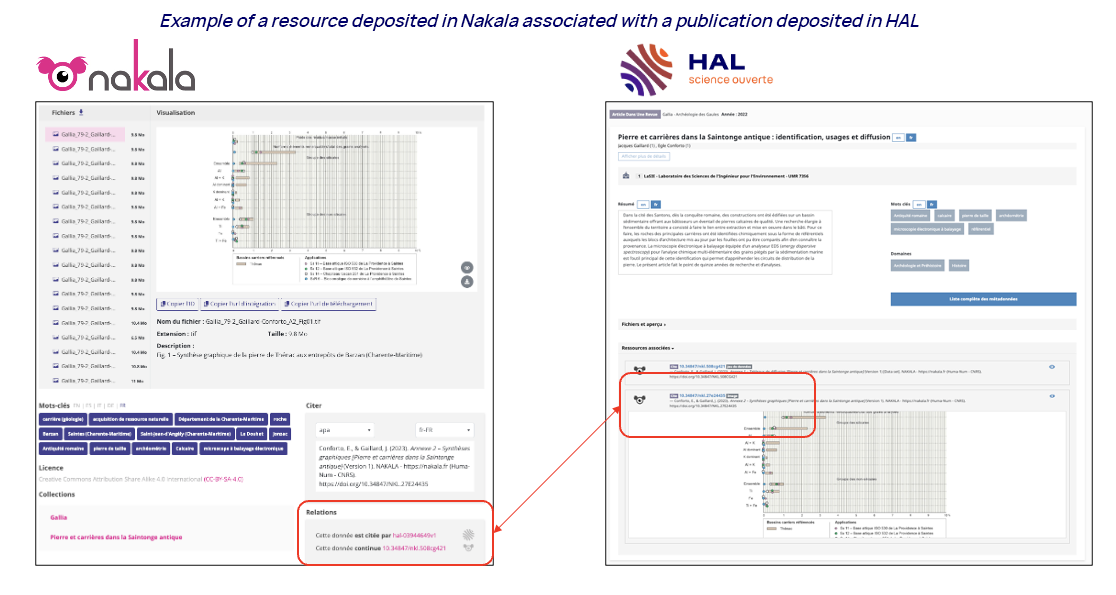The partnership between HAL and Nakala aims to make it easier to find datasets associated with a publication, or publications associated with a dataset. The infrastructures’ role is to provide a straightforward system for reliably linking data stored in Nakala to publications on HAL, based on recognised standards.The two platforms now use the same automatic metadata exchange protocol, making it easier to discover the relationships between publications and datasets.
Achieving interoperability between platforms for depositing and archiving research publications and data is a major challenge for open science. Exchanging metadata between systems facilitates the discovery of scientific output in line with the FAIR principles.
Linking a publication deposited in HAL to a dataset
The evolution of the HAL system of relationships between resources, implemented at the start of the year, enables to enrich and refine the way in which publications deposited in HAL are associated with datasets, images, or software available on other platforms. This is partly based on a partnership with the Nakala, Recherche.data.gouv and Software Heritage repositories.
- This facilitates data entry at the time of deposit, enabling depositors to search by title, author, etc.
- It also allows users to display and preview the data or associated software when consulting the HAL deposit, thereby increasing the visibility and accessibility of the linked research results.
Linking a Nakala deposit with a HAL deposit
The section of the form dedicated to relations between public data deposited in Nakala has evolved and been extended to the HAL platform.
Creating relations from a Nakala repository to a publication deposited in the HAL open archive has been made easier:
- by selecting the HAL repository,
- by entering the HAL identifier for the resource.
This improves the visibility of scientific publications linked to research data.
Automatic notifications and synchronisation
The partnership between HAL and Nakala has entered a new phase: the two platforms are enhancing their ability to exchange and display metadata thanks to the implementation of the COAR Notify protocol.
This protocol automates communication between the two platforms. For example, if a HAL repository mentions a resource that has already been archived in Nakala, HAL automatically sends a notification to Nakala. Nakala can then update the resource with the HAL identifier. The process also functions in the other direction: if data is deposited on Nakala that is related to a document deposited in HAL, Nakala can inform HAL of this.
Currently, there are 115 HAL repositories that reference one or more Nakala-archived resources, and these resources are now updated on the platform with the associated publication’s HAL identifier.

This system improves synchronisation between the two services, making information more visible and better linked. It facilitates researchers’ work (as updates are automatic), improves metadata quality and strengthens consistency between publication and research data repositories.
From the EOSC-Pillar project to COMMONS
Interoperability between HAL and Nakala is a long-term project. CCSD and Huma-Num, the operators of these two platforms, have joined forces as part of the European EOSC-Pillar project. The EOSC-Pillar project, which started in 2019, coordinated national open and shared science efforts in Austria, Belgium, France, Germany and Italy. It ended in 2022. The collaboration aimed to demonstrate a proof-of-concept (PoC) of the FAIRification of data in the social sciences and humanities. The collaboration explored the management of relationships between resources, the identification of existing standards, and the display of Nakala metadata in HAL.
This partnership is ongoing through the numerous collaborations established between the EquipEx+ COMMONS project, which is supported by OpenEdition, Métopes and IR* Huma-Num, and the EquipEx+ HALiance project, which is supported by CCSD.
The COMMONS project aims to create reliable connections between data stored in Nakala and publications on OpenEdition platforms in the humanities and social sciences.
Automating these links contributes to the implementation of the FAIR principles (Findable, Accessible, Interoperable and Reusable) and facilitates the valorisation of research results. This is achieved by ensuring a better flow of information between the HAL and Nakala platforms and by publishing these relationships in a standardised form, enabling content aggregators to display them correctly.